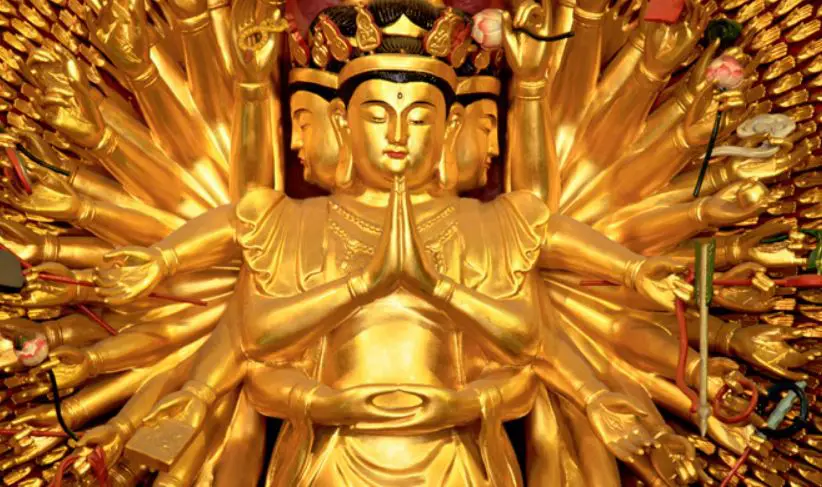The Decline of Buddhism in India | UPSC – IAS
The decline of Buddhism has been attributed to various factors, especially the regionalisation of India after the end of the Gupta Empire, which led to the loss of patronage and donations as Indian dynasties turned to the services of Hindu Brahmins.
Buddhism expanded in the Indian subcontinent in the centuries after the death of the Buddha, particularly after receiving the endorsement and royal support of the Maurya Empire under Ashoka in the 3rd century BCE. It spread even beyond the Indian subcontinent to Central Asia and China.
From its beginnings in India, Buddhism’s strongest appeal had been to kshatriya rulers and vaishya businessmen, who felt that brahmin priests did not respect them. The Buddha himself came from a kshatriya family, and his early friendship with the kshatriya kings of Magadha and Kosala had ensured their support for his movement.
Later kings and merchants also donated huge sums of money to support Buddhist monks, temples, and monasteries. Many people of the lower castes, who felt the weight and the arrogance of all the other castes pressing down on them, also joined the newly forming religion. They were especially attracted by the use of the vernacular Pali and Magadhi languages in place of Sanskrit, and the absence of the financial demands of the brahmins.
Causes of decline of Buddhism | UPSC – IAS
Buddhism began to lose strength in India around the time of the decline of the Gupta Empire (c. 320–550 c.e.). Regional rulers began to choose Hinduism over Buddhism, and alliances with priests rather than with monks. At the popular level, lower castes – who had found the anti caste philosophy of Buddhism attractive- apparently also began to shift their allegiance back toward more orthodox Hinduism as an anchor in a time of political change.
- Invasions of north India by various groups such as Huns, Turco-Mongols and Persians and subsequent destruction of Buddhist institutions such as Nalanda and religious persecutions.
- Religious competition with Hinduism and later Islam were also important factors.
- Islamization of Bengal and demolitions of Nalanda, Vikramasila and Odantapuri by Muhammad bin Bakhtiyar Khalji, a general of the Delhi Sultanate are thought to have severely weakened the practice of Buddhism in East India.
- Also, without imperial assistance, merchants’ incomes may have decreased within India, reducing their contributions to Buddhist temples. By the fifth century c.e., the Chinese Buddhist pilgrim Faxian noted weaknesses in Indian Buddhism. Mahayana Buddhism, with its many godlike Buddhas and bodhisattvas inhabiting a multitude of heavens, seemed so close to Hinduism that many Buddhists must have seen little purpose in maintaining a distinction.
- Finally, Buddhists throughout their history in India had relied on Hindu brahmin priests to officiate at their life-cycle ceremonies of birth, marriage, and death, so Hindu priests could argue that they always had a significant claim on Buddhist allegiance.
- Readers who are accustomed to the monotheistic pattern of religions claiming the undivided loyalty of their followers will recognize here a very different pattern.
- Many religions, especially polytheistic religions, expect that individuals will incorporate diverse elements of different religions into their personal philosophy and ritual. We will see more examples of this personal syncretism and loyalty to multiple religions as we examine Buddhism’s relationship with Confucianism in China and with both Confucianism and Shinto in Japan.
As Hinduism evolved, it became more attractive to Buddhists. Theologians such as Shankaracharya (788–820 c.e.) and Ramanuja (c. 1017–1137 c.e.) advanced philosophies based on the Vedic literature known to the common people, and built many temples and schools to spread their thought. At the same time, Hinduism, following its tradition of syncretism, incorporated the Buddha himself into its own polytheistic universe as an incarnation of Vishnu.
- A devotee could revere the Buddha within the overarching framework of Hinduism. Finally, neither Buddhism nor Hinduism gave much scope to women within their official institutions of temples, schools, and monasteries. For Hinduism, however, the home was much more central than the public institution, and here women did have a central role in worship and ritual. Buddhism was much more centered on its monasteries and monks. The comparative lack of a role for women, and the comparative lack of interest in domestic life generally, may have impeded its spread.
Buddhism in India declined still further when Muslim traders gained control of the silk routes through central Asia. The final blow came with the arrival of Muslims during the first two centuries of their major invasions of India, between 1000 and 1200 c.e.
Muslims saw Buddhism as a competitive, proselytizing religion, unlike Hinduism, and did not wish to coexist with it. Because Buddhism was, by this time, relatively weak and relatively centralized within its monasteries and schools, Muslims were able to destroy the remnants of the religion by attacking these institutions.
Buddhist monks were killed or forced to flee from India to centers in
- Southeast Asia,
- Nepal, and
- Tibet.
Hinduism survived the challenge because it was much more broadly based as the religion of home and community and far more deeply rooted in Indian culture. In the 1950s, almost 1,000 years after Buddhism’s demise in India, about five million “outcastes” revived Buddhism in India in protest at the inequalities of the caste system, and declared their allegiance to the old/new religion. These “neo-Buddhists” are almost the only Buddhists to be found in India today.
The total Buddhist population in 2010 in the Indian subcontinent – excluding that of Sri Lanka, Nepal and Bhutan – was about 10 million, of which about 7.2% lived in Bangladesh, 92.5% in India and 0.2% in Pakistan.
Read more in Detail:-Buddhism | Origin, History, Spread, & Facts



